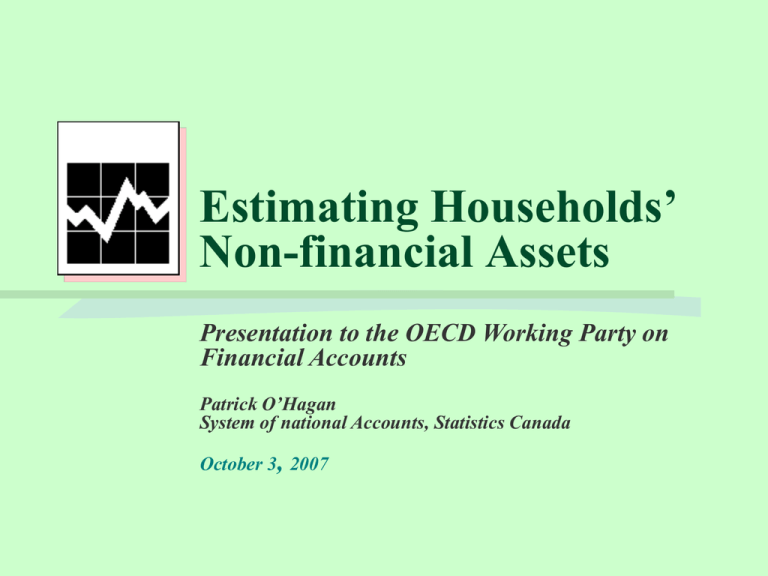Estimating Households’ Non-financial Assets Presentation to the OECD Working Party on Financial Accounts
advertisement

Estimating Households’ Non-financial Assets Presentation to the OECD Working Party on Financial Accounts Patrick O’Hagan System of national Accounts, Statistics Canada October 3, 2007 Background Set of quarterly balance sheet accounts – National Balance Sheet Accounts (NBSA) – including nonfinancial asset estimates for all relevant sectors of the economy …times series beginning in 1961. Estimates available about 75 days after the reference period National wealth (non-financial assets) covers produced and non-produced assets. National wealth is broken down into institutional sectors … exception natural resources No household sector per se but rather an institutional sector called Persons and Unincorporated Business – households, unincorporated business (including farms) and non-profit institutions serving households. Non-financial assets related to specifically to households ─ residential real estate and consumer durable stocks. Residential real estate broken down into structures and land Residential structures – aggregate estimates Estimates of the total residential housing stock are constructed using the perpetual inventory method (PIM) -- rrequiring info about the value of investments, price indexes, average services lives of the capital, and the choice of a depreciation method. Starting point is a stock estimate using the market value data provided by the 1941 Census. Service life assumptions are also based on Census data. The value of demolitions and destruction are also estimated and deducted from the housing stock estimates Investment flow (by region) data includes new construction, renovations (excluding repairs) and other fees associated with new residential building transactions. Implicit price index built from a series of (largely regional for new construction) price indexes Household sector stock of residential structures Direct estimates of the marginal amounts of government housing. Allocating the housing stock to business and households. Housing stock data, by type and tenure (rented-owned, occupied, non-occupied), are used as the primary method to allocate housing between the corporate and persons and unincorporated business sector. The corporate sector ─ the bulk of apartment buildings, significant proportions of row housing, and minimal proportions of singles-doubles ─ is constructed. Original cost estimates of corporate sector allocations are cross-checked against book value data for the real estate industries from the enterprise survey statistics Residual, by housing type, becomes the estimate for published housing stock of the Persons and unincorporated business sector. Rental units, by type, assumed to be unincorporated business. In line with the approach for sectoring of housing investment. Estimating land surrounding residential structures Estimates derived by land-to-structure ratios (LSR). LSR are calculated by looking at new building activity by type (singles or multiples) across the country. This includes regional estimates further broken down into census metropolitan areas (CMAs). Selecting three key details of all units sold in a year – BPV, APV, location APV is the sale value of the total residential real estate unit. Building permit values (BPV) are adjusted for under-reporting in the national accounts and this same adjustment factor is applied to the BPV for this exercise. LSR = (APV-BPV)/BPV Estimating land surrounding residential structures (cont’d) The physical address of the unit completed and sold allows for identification of whether a unit is in a suburban area of a major city (the vast majority of new units) or in the urban centres (very limited amount of infill). LSR are always higher in urban core areas, and a further adjustment is made to the L/S to account for the higher depreciation of older buildings in urban core areas. Census weights are then used to aggregate the LSR over CMAs and by region, such that an economy-wide LSR for singles and multiples are derived to apply to the estimates of residential housing stock. Current period estimates of land; household sector estimates of land Approach is labour-intensive and APV come in with a delay, such that this detailed methodology is typically 3-4 years behind the current data LSR projected into the current period (and estimated quarterly) using a set of current quarterly indicators of real estate activity and prices. Reliability has not proven to be a problematic issue Sector estimates of land based sectoring of single and multiple structures using the LSR. The higher proportion of single dwellings in the household sector makes for a larger LSR for that sector Household residential real estate Residential structures and land surrounding residential structures are constructed separately and then added together to derive total residential real estate Notably, household sector macro estimates (the bulk of residential real estate) are very close to the independently-derived household assetdebt survey aggregated micro data estimates. A project to evaluate municipal residential real estate assessment data may provide a second cross-check on the estimates of residential property in the NBSA Stocks of consumer durable goods Also derived using the perpetual inventory method, using info on expenditures, price indexes, average service life assumptions and the choice of depreciation method. There is no benchmark opening stock. Rather quarterly expenditure data back to 1947q1 are used to build 1961q1 data, which is appropriate given that the longest average service life used is 14 years. Average service lives are similar to those used in the U.S., with the exception of motor vehicles where a shorter life is used. Depreciation is calculated using straight line depreciation for all durables, except for new motor vehicles (geometric) Implicit deflators for all commodities are data are taken directly from the national accounts databases for personal expenditure on goods and services Leased motor vehicles included in expenditure-stock Relative impact of household non-financial assets Represent 43% of total assets of this sector … contribute significantly to changes in household net worth. With a housing boom over most of the last 5 years, the driving force behind many quarters’ changes in net worth has been additions to and revaluations of the stock of residential real estate Leverage with respect to accumulated debt related to residential real estate and consumer durables has not increased … remaining in the 18% range over the last 5 years, despite acceleration in borrowing over this period. This reflects, in part, the strong appreciation of both household non-financial and financial assets over this same period Household non-financial assets (including consumer durables) account for a significant proportion of national wealth – specifically, 44% of economy-wide produced assets and land (excluding natural resources) Household non-financial assets % national wealth (produced assets) 100 90 80 70 % 60 50 40 30 20 10 0 1990 1991 1992 1993 1994 1995 1996 1997 1998 1999 1990 - 2006 2000 2001 2002 2003 2004 2005 2006 Household non-financial assets to total assets 100 90 80 70 % 60 50 40 30 20 10 0 1990 1991 1992 1993 1994 1995 1996 1997 1998 1999 1990 - 2006 2000 2001 2002 2003 2004 2005 2006 Household non-financial assets, financial assets and net worth Household non-financial assets Household total financial assets Household net worth 6000000 5000000 millions 4000000 3000000 2000000 1000000 0 1990 1991 1992 1993 1994 1995 1996 1997 1998 1999 1990 - 2006 2000 2001 2002 2003 2004 2005 2006






